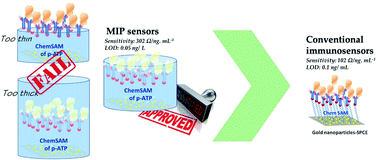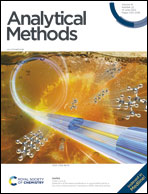A highly sensitive impedimetric sensor based on a MIP biomimetic for the detection of enrofloxacin†
Abstract
The benefits of molecularly imprinted polymer (MIP) technology in creating artificial receptors to replace natural counterparts have piqued the interest of numerous researchers in recent years. We propose a biomimetic enrofloxacin-MIP for enrofloxacin (ENRO) antigen detection using gold nanoparticles (AuNPs) and MIP methodologies in this study. A self-assembled monomer layer of aminothiophenol was used to immobilize a pre-formed complex of the anti-enrofloxacin monoclonal antibody and enrofloxacin antigen onto the surface of an AuNP coated screen-printed carbon ink electrode (SPCE). The poly-(aminothiophenol) layer thickness was adjusted to entrap and restrict enrofloxacin antigens near the surface. The imprinting and removal of the enrofloxacin antigen in the MIP film were strongly validated by the Raman spectra. The final mAb-MIP sensor had better sensitivity (302 Ω mL ng−1) and a better detection limit (0.05 ng mL−1) than self-assembled monolayer (SAM)-based immunosensors, which had 102 Ω mL ng−1 and 0.1 ng mL−1, respectively.



 Please wait while we load your content...
Please wait while we load your content...